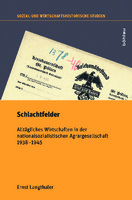Schlachtfelder
Alltägliches Wirtschaften in der nationalsozialistischen Agrargesellschaft 1938–1945
| dc.contributor.author | Langthaler, Ernst | |
| dc.date.accessioned | 2016-12-31 23:55:55 | |
| dc.date.accessioned | 2020-01-28 13:52:39 | |
| dc.date.accessioned | 2020-04-01T14:21:51Z | |
| dc.date.available | 2020-04-01T14:21:51Z | |
| dc.date.issued | 2016 | |
| dc.identifier | 594631 | |
| dc.identifier | OCN: 1000072442 | en_US |
| dc.identifier.uri | http://library.oapen.org/handle/20.500.12657/32890 | |
| dc.description.abstract | Taking the province of Niederdonau as an example, this pioneer study highlights everyday fields-of-force between National Socialism and agrarian society in which rural actors competed for resources among themselves and with official functionaries. The megaproject of ‘volkish productivism’ – the creation of an efficient peasantry in ‘racial’ and economic terms – got stuck with regard to technical development. However, with regard to institutional development, there emerged a pathway towards an alternative modernity beyond Liberalism and Communism. | |
| dc.language | German | |
| dc.subject.classification | thema EDItEUR::R Earth Sciences, Geography, Environment, Planning | en_US |
| dc.subject.other | agrarian society | |
| dc.subject.other | agriculture | |
| dc.subject.other | everyday life | |
| dc.subject.other | productivism | |
| dc.subject.other | National Socialism | |
| dc.subject.other | Second World War | |
| dc.subject.other | Austria | |
| dc.subject.other | Agrargesellschaft | |
| dc.subject.other | Landwirtschaft | |
| dc.subject.other | Alltagsleben | |
| dc.subject.other | Produktivismus | |
| dc.subject.other | Nationalsozialismus | |
| dc.subject.other | Zweiter Weltkrieg | |
| dc.subject.other | Österreich | |
| dc.subject.other | Hektar | |
| dc.subject.other | Reichsmark | |
| dc.title | Schlachtfelder | |
| dc.title.alternative | Alltägliches Wirtschaften in der nationalsozialistischen Agrargesellschaft 1938–1945 | |
| dc.type | book | |
| oapen.abstract.otherlanguage | Diese Pionierstudie beleuchtet am Beispiel des Reichsgaues Niederdonau alltägliche Kräftefelder zwischen Nationalsozialismus und Agrargesellschaft, in denen ländliche Akteure untereinander und mit Funktionsträgern um Ressourcen rangen. Das Entwicklungsprojekt des ‚völkischen Produktivismus‘ – die Erzeugung eines „rassisch“ und wirtschaftlich leistungsfähigen „Bauerntums“ – blieb zwar in technischer Hinsicht stecken. Jedoch stellte es in institutioneller Hinsicht die Weichen der Agrarentwicklung in Richtung einer alternativen Moderne jenseits von Liberalismus und Kommunismus. | |
| oapen.identifier.doi | 10.26530/oapen_594631 | |
| oapen.relation.isPublishedBy | af16fd4b-42a1-46ed-82e8-c5e880252372 | * |
| oapen.relation.isFundedBy | 26ae1657-c58f-4f1d-a392-585ee75c293e | |
| oapen.relation.isbn | 9783205200659 | |
| oapen.collection | Austrian Science Fund (FWF) | |
| oapen.imprint | Böhlau | |
| oapen.pages | 946 | |
| oapen.place.publication | Wien; München | |
| oapen.grant.number | PUB 278 | |
| oapen.remark.public | Relevant Wikipedia pages: Hektar - https://de.wikipedia.org/wiki/Hektar; Landwirtschaft - https://de.wikipedia.org/wiki/Landwirtschaft; Reichsmark - https://de.wikipedia.org/wiki/Reichsmark | |
| oapen.identifier.ocn | 1000072442 |

